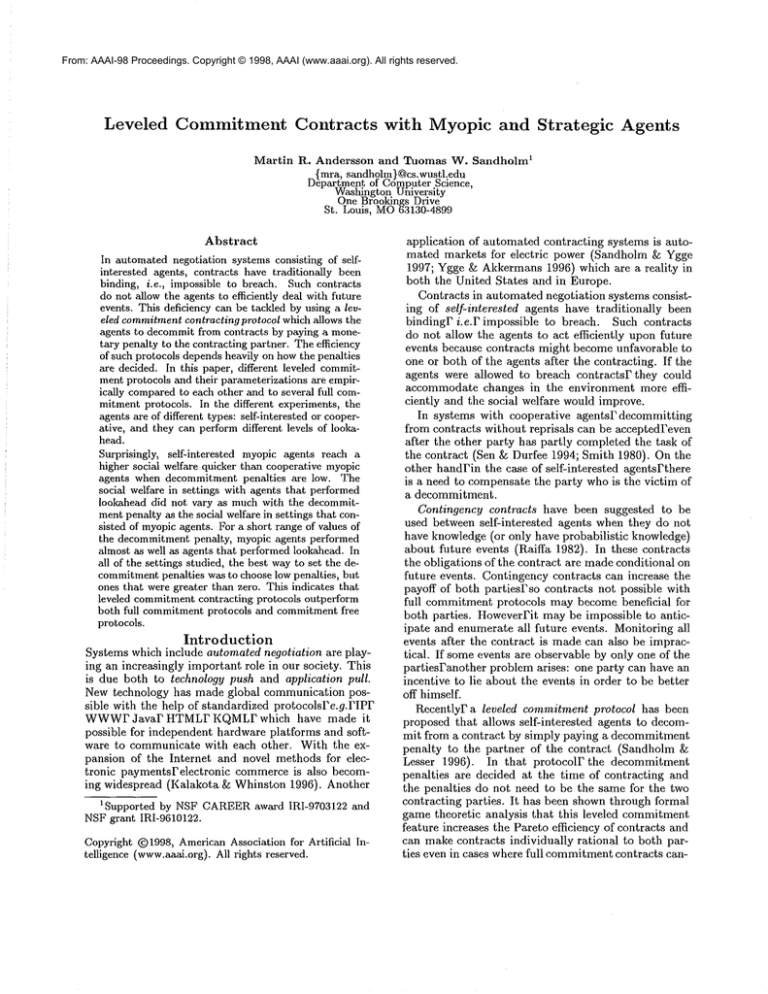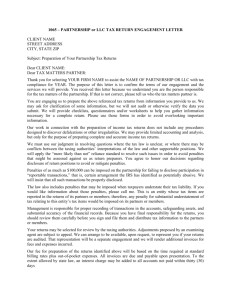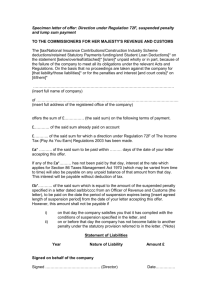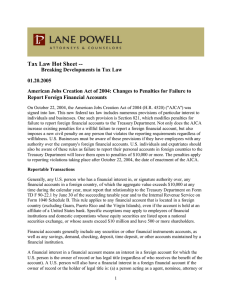
From: AAAI-98 Proceedings. Copyright © 1998, AAAI (www.aaai.org). All rights reserved.
Leveled
Commitment
Contracts
1Martin
with
Myopic
and Strategic
Agents
R. Andersson and Tuomas W. Sandholm
{mra, sandholm} @cs.wustl.edu
Department of Computer Science,
Washington Uhiversity
One Brookings Drive
St. Louis, MO63130-4899
Abstract
In automated negotiation systems consisting of selfinterested agents, contracts have traditionally been
binding, i.e., impossible to breach. Such contracts
do not allow the agents to efficiently deal with future
events. This deficiency can be tackled by using a leveled commitmentcontracting protocol which allows the
agents to decommit from contracts by paying a monetary penalty to the contracting partner. The efficiency
of such protocols depends heavily on howthe penalties
are decided. In this paper, different leveled commitment protocols and their parameterizations are empirically comparedto each other and to several full commitment protocols. In the different experiments, the
agents are of different types: serf-interested or cooperative, and they can perform different levels of lookahead.
Surprisingly, self-interested
myopic agents reach a
higher social welfare quicker than cooperative myopic
agents when decommitment penalties are low. The
social welfare in settings with agents that performed
lookahead did not vary as much with the decommitment penalty as the social welfare in settings that consisted of myopicagents. For a short range of values of
the decommitment penalty, myopic agents performed
almost as well as agents that performed lookahead. In
all of the settings studied, the best wayto set the decommitmentpenalties was to choose low penalties, but
ones that were greater than zero. This indicates that
leveled commitmentcontracting protocols outperform
both full commitment protocols and commitment free
protocols.
Introduction
Systems which include automated negotiation are playing an increasingly important role in our society. This
is due both to technology push and application pull.
New technology has made global communication possible with the help of standardized protocolsFe.g.PIPF
WWWPJavaP HTMLP KQMLF which have made it
possible for independent hardware platforms and software to communicate with each other. With the expansion of the Internet and novel methods for electronic paymentsFelectronic
commerce is also becoming widespread (Kalakota 8z Whinston 1996). Another
1Supported by NSF CAREERaward IRI-9703122
NSF grant IRI-9610122.
and
Copyright Q1998, American Association for Artificial
telligence (www.aaai.org). All rights reserved.
In-
application of automated contracting systems is automated markets for electric
power (Sandholm ~ Ygge
1997; Ygge ~ Akkermans 1996) which are a reality in
both the United States and in Europe.
Contracts in automated negotiation systems consisting of self-interested
agents have traditionally
been
bindingF i.e.Fimpossible
to breach. Such contracts
do not allow the agents to act efficiently upon future
events because contracts might become unfavorable to
one or both of the agents after the contracting. If the
agents were allowed to breach contractsP they could
accommodate changes in the environment more efficiently and the social welfare would improve.
In systems with cooperative agentsPdecommitting
from contracts without reprisals can be acceptedPeven
after the other party has partly completed the task of
the contract (Sen ~ Durfee 1994; Smith 1980). On the
other handPin the case of self-interested
agentsPthere
is a need to compensate the party who is the victim of
a decommitment.
Contingency contracts have been suggested to be
used between self-interested
agents when they do not
have knowledge (or only have probabilistic
knowledge)
about future events (Raiffa 1982). In these contracts
the obligations of the contract are made conditional on
future events. Contingency contracts can increase the
payoff of both partiesFso contracts not possible with
full commitment protocols may become beneficial
for
both parties.
HoweverFit may be impossible to anticipate and enumerate all future events. Monitoring all
events after the contract is made can also be impractical. If some events are observable by only one of the
partiesPanother problem arises: one party can have an
incentive to lie about the events in order to be better
off himself.
Recently[’ a leveled commitment protocol has been
proposed that allows self-interested
agents to decommit from a contract by simply paying a decommitment
penalty to the partner of the contract (Sandholm
Lesser 1996). In that protocolF the decommitment
penalties are decided at the time of contracting and
the penalties do not need to be the same for the two
contracting parties. It has been shown through formal
game theoretic analysis that this leveled commitment
feature increases the Pareto efficiency of contracts and
can make contracts individually rational to both parties even in cases where full commitment contracts can-
not.
The leveled commitment contractsPwhich
only can
handle one taskPcould emulate full commitment contracts that are capable of handling several tasks in one
single contract (Andersson 1998; Andersson & Sandholm 1998; Sandholm 1996; 1998).
With leveled commitment protocols there is no need
for an agent to conduct a feasibility check before contracting. If the contract cannot be performedFbecause
of lack of resources etc.Fthe agent can deeommit from
the engagement. AlsoFthe agents do not need to perform a complete computation of the marginal costs before taking on a contractPbut can complete the com~
putation after contracting.
The concept of breaching contracts in the real world
is analyzed by Posner (Posner 1977). The main ideas
are that the party that breaches must compensate the
victim for lost profit and that the penalties for breaching contracts should be set so that the social welfare is
maximized.
Strategic thinking behind contracting and one-sided
decommitment among self-interested
agents has been
studied (ParkPDurfeeF& Birmingham 1996)Pwhere the
decision making mechanism is modeled as a Markovprocess. They assume that the agents expect none of
their bids to be acceptedFwhich makes the approach
unsound from the perspective of game theory.
Diamond and Maskin (Diamond & Maskin 1979)
have studied systems in which both agents can decommit from a contract by paying a decommitment penalty
to the other party of the contract. Those penalties can
be set in different
ways: they can be compensatory
or privately decided (i.e. liquidated; not necessarily
decided by the parties of the contract - maybe imposed by a court) in the contract. The compensatory
decommitment penalties are favored because of efficiencyF i.e.F they provideP whenever possibleP an increasing mutual welfare between the agents that enter
a new contract, z Another argument for the compensatory penalties is that they are exactly the penalties
that two rational parties would agree on for privately
4decided penalties.
2This allows the agent to act faster and with less constraints in the contracting process than if it always had to
perform a feasibility check and a thorough marginal cost
calculation before contracting. The system also becomes
more efficient if one agent (the one that takes on the task)
conducts a full marginal cost calculation, than if all the
agents would perform such a calculation.
3However, the social welfare may decrease because of
the inefficiency arising from the contract that is breached.
4One reason for having over-compensating penalties is
that one agent can make himself more trustworthy and the
expected utility of the other agent will increase enough to
make the contract possible (Posner 1977). Hence, overcompensating penalties can increase the space of possible
contracts. However, it would limit the space of possible
decommitments.
The next section discusses leveled commitment protocols.
ThenF the example problem domain is describedFwhich is followed by a presentation of the types
of agents and protocols included in the study. NextPis
the notation of the different protocols presentedPfollowed by a description
how the data was evaluated.
Then the results are presented and discussed.
Leveled
Commitment
Protocols
The penalties could be chosen freely by the agentsPin
which case the agents would try to optimize the penalties in its favor (Sandholm &: Lesser 1996). The negotiation will be more complex if the agents can decide
the penalties
themselves compared to when they are
set by the protocol because there would be more variables to agree on in order for all parties to accept a
contract. If the penalties are set by the protocolPthe
negotiation becomes easierPbut the result may not be
optimal (e.g. fixed penalties does not guarantee that
it is is profitable for the agents to decommitin all situations when a decommitment is mutually profitable
for the agents involved in the contract).
Another method is to relate
the decommitment
penalty to the price of the contract.
This could be
done by choosing the penalty as a percentage (or
more complex function) of the price. Another way is
to make the penalties
compensate the victim of the
breach for its lost profit. Because the victim would
have an incentive to lie about the expected profitPa
mechanismfor calculating the lost profit would be necessary. The state of both agents might have changed
since the contract was madePso the expected lost profit
at contracting time and breaching time may differ. In
the extreme the lost profit for the victim can be negative at breaching timePthat isPalso the victim of the
breach benefits from being freed from the contract obligations.
A breach close to the execution deadline of the contract or late in a negotiation is likely to be more costly
for the victim since it can be hard to find someone else
to contract with within a short amount of time. In
order to prevent such occurrencesPthe
decommitment
penalties can be increased over time.
The leveled commitment protocols were studied in
order to conclude which mechanism should be used
for setting the decommitment penalties
among qualitatively different agents. Several environments were
studiedFand in each of themPl6 protocols with many
parameterizations were tested.
Description
of the Problem Domain
To investigate the performance of different mechanisms
of setting the decommitment penalty for leveled commitment protocolsPthe agents are divided into two subsets. One subset consisted of contractors which each
had one task with a cost associated to it. A contractor considers to contract out its task to a contractee
which would be able handle the task at a potentially
cheaper cost. The other subset consists of the con-
tractees which do not have any tasks initiallyFbut resources to handle a maximumof one task at a cost
specific to each combinationof contractees and tasks.
There is no other differences between a contractor and
a contractee other than that the former initially has
a task and is willing to give it awayFandthe latter is
willing to take on a task. The fallback position of a
contractor is the cost of handling the task it has at
the start of the negotiationFwhile the fallback of the
contractees are zero (i.e.Fthey do not have any tasks
at the start of negotiation and therefore no pending
expenses).
an agent wants to decommitmentfrom the underlying
contractF it has to pay the decommitmentpenalties
5stated in F to all agents involved in the contract.
Four different mechanisms of deciding the decommitment penalties are studied: fixed; percentage of
contract price; increasing and decided at the time of
contracting; and increasing and decided at the time
of breaching. Twomore properties (how to compute
the price of the contractF and the sequence in which
the agents meet each other in the negotiation) are also
varied for different protocols in the study. All of these
alternatives are nowdiscussed.
Types of Agents
Four types of agents are included in the study. Each
type is designed from two properties: the amount of
lookahead the agent performs before it accepts or rejects a proposed contractFand howself-interested the
agent is.
Decommitment Penalties
as a Fixed Value
(FiX-protocol)
In the FIX-protocolFall contracts have the same fixed
decommitment
penalty decided prior to the start of the
negotiation and that penalty is used throughout the
negotiation. In the studyFexperiments with six different values of the fixed decommitmentpenalty were
conducted. A summaryof the different values can be
found in Table 1.
Decommitment Penalties
as a Percentage
of Contract
Price (PER-protocol)
The percentage decommitmentpenaltiesFused in the
PER-protocolFconsistof a fraction of the price of the
contract. It is referred to as percentage since the most
efficient parameterizations are fractions less than one.
The same percentage is used for all contracts throughout the negotiation. The percentages in the study can
be found in Table 1.
FIX-protocol
PER-protocol
CON-protocol
BRE-protocol
0
0.1
0.25
5
0.25
0.5
10
0.4
0.75
15
0.5
1.0
3O
0.75
2.0
5O
1.0
4.0
Agents With and Without Lookahead
The agents can either perform full lookahead or none
at all. If they perform full lookaheadPtheycomputethe
payoff of all possible future events and agree to the contract only if the expected payoff of agreeing is greater
than rejectingPi.e.Fthey act strategically as gametheoretic agents would. The other option of lookahead is
to do none at all. If the agents perform no lookatleadF
they act myopicallyFand only consider the immediate
payoff of the contract under negotiation.
Individual
Rational and Cooperative
Agents
The agents can be self-interested (SI) and only agree to
contracts which increase their ownpayoff (expected or
immediateFdepending on whether they perform lookahead or not). They could also be explicit social welfare
maximizers ( SWF-maximizer)Fi.e. cooperative agentsP
which consider the summedpayoff of all agents in the
system when deciding to accept or reject a contract.
That isFa SWF-maximizingagent can agree to a contract even if it makesitself worse offf’as long as the
total social welfare in the systemincreases.
Table 1: Parameterizationsin the study o/ leveled commitment protocols in different environments. (Note that 10~
is written as 0.1 in the table.)
Types
of
Leveled
Commitment
Protocols
The leveled commitmentcontracts are defined as follows:
Definition. 1 A leveled commitmentcontract is a tuple (C, F), where C is the underlying full commitment
contract and F is the set of decommitmentpenalties.
Let Ac be the set of agents involved in the contract C.
Then F will consist of one decommitmentpenalty for
each pair of agents in Ac, so that IFI = IAcl2-1Acl
2
This definition has the nice feature of separating the
leveled commitment framework from the obligations
of the contractFcalled the underlying contract C. This
means that the leveled commitment protocol can be
applied to any type of full commitmentcontract. If
Decommitment Penalties
Decided at Time
of Contracting
(CON-protocol)
In the CON-protocolF the decommitment penalty
varies during the negotiation. For a certain contractF
the decommitmentpenalty is fixed at the time of contracting. The decommitmentpenalty is linearly increasing from zero to the highest penalty used. This
highest penalty is set by the protocol to be a percentage of the contract priceFwhichis applied to a contract
STheconcept of leveled commitment
is not specific to
task allocation problems,althoughthe empiricalstudies of
this paper focus on task allocation. All the leveled commitment protocols in this study have a full commitment
contract that only can transfer one task from one agent to
another as the underlying full commitment
contract.
agreed on at the second to last round and then decommitted in the last round. The percentages for setting
the highest penalty in the study can be found in Table 1.
Decommitment
Penalties
Decided
at Time
of Breaching
(BRE-protocol)
In BRE-protocols
the decommitment penalty also
varies with the time of the negotiationPas in the CONprotocol.
The difference
is that the decommitment
penalties are fixed at the time of breaching instead of
the time of contracting.
The decommitment penalty
is linearly increasing over time and a contract which is
decommitted in the last round has the highest penalty.
This highest penalty is decided as a percentage of the
contract price and Table 1 shows the percentages used
in the study.
Methods
of Computing
the Contract
Price
The price of a contract is set such that the profit of the
contract is divided equally between the agents involved
in the contract. HoweverPthe profits are calculated in
two different ways: including and not including decommitment penalties:
¯ The price is set so that the profits from the fallback
positions of the agents are divided equally between
the agents. The current payoffs are not considered
when the price is calculated and neither are the potential decommitment penalties.
¯ The price is set so that the increase from the current
mutual profit of the agents is equally divided between themPincluding discounts for decommitment
penalties that are to be paid.
Sequencing
of Contracts
The order in which the agents meet for negotiation
is either stochastic or deterministic. In the stochastic
modelPone contractor and one contractee are randomly
picked to negotiate with each other. In the deterministic modelPthe order is decided prior to negotiation
(contractor
1 meets contractee 1Pcontractor 1 meets
contractee 2P...Pcontractor
2 meets contraetee 1P...).
The negotiation protocol is sequentialrthat isPonly two
agents (one contractor and one contractee) negotiate
a time.
If the agents are individually rationalPa contract is
accepted if the payoffs (immediate or with lookahead)
after the contract will be greater for both the contractor and the contractee compared to the payoffs before
a potential acceptance of the contract. If one of the
agents is indifferentPthat
isPthe contract does not increase its payoffl~he other agent decides whether or not
to perform the contract.
HoweverPif both the agents
are indifferentFthe contract is rejected.
Studied
Parameterizations
The parameterizations
of the leveled commitment protocol that were studied can be found in Table 1. The
Notation of a leveled commitmentprotocol in s certain
domain: Cab.Dd. Cab characterizes the protocoi and
Dd the domain.
CE{FIX,PER,
The type of penalty.
CON,BRE}
ae{w, d}
The type of price computation:
based on fMlback positions (w)
current profit(d).
be{n, r}
The contract sequencing: random (r)
or not random (n).
De{SI, SWF} Agent type: willingness to cooperate:
self-interested (SI)
cooperative (SWF).
de{l, m}
Agent type: lookahead depth:
lookahead (1) or no lookahead
(myopic) (m).
Table 2: Notation o/the leveled commitment protocols and
the domain.
percentages
for CON- and BRE-protocols
are considerably greater than the percentages for the PERprotocol.
This is because in the CON- and BREprotocols these great percentages are only used in the
last negotiation roundPsince the penalty is increased
linearly from zero to the specified percentage with time
of negotiation.
Conventions
in Naming the
and Domains
Protocols
The notation for the different combinations of features
of the leveled commitment protocols is summarized in
Table 2. One or more properties may be left out if it
is clear from the context which properties are referred
to. If there is a star ("*") in place of a propertyFall
possible types of that property are considered.
Evaluation
In our experimentsP two contractors
negotiated with
two contractees over the contractors’ initiM tasks. InitiallyPeach agent was randomly assigned a cost for handling each task. The contractors’
costs were in the
interval [100,200] and the contractees’ in the interval
[0,100]. Since the contractors never can handle a task
cheaper than a contracteePthey never have to negotiate
with each other. The problem was solved for 100 randomly initiated problem instances with five negotiation
rounds in each. The number of negotiation rounds was
assumed common knowledge among the agents.
To compare the different protocolsPthe ratio bound
(ratio of the welfare of the obtained local optimumfor
given type of contracts to the welfare of the global optimum) was used. The mean ratio bounds (over the 100
problem instances) were calculated for all the different
leveled commitment protocols
and agents. The 95%
confidence intervals
were also computed from which
6the results could be statistically analyzed.
2.6
2.4
FlXwn.SII
-¢-.FlXdn.SII-)*-FIXwn.SWFI
-EP-- "
FlXdn.SWFI
--x---
2,2
2
1.8
Results
The results are presentedin the following order: FirstF
the agent types are comparedFthenthe methods of
sequencingthe contractsFthedifferent waysof deciding
on a contract priceF and the best protocols for each
agent type are discussed.
1.6
Comparison of Agent Types
Over allFagents which performed lookahead reached
a higher social welfare than myopicagents. By defi1.2
:>-J:c-}
............
t
...........................
:::=|..:=:
.....................
nition
the SWFl-agents(SWF-maximatorsconducting
~........
.,.--_~
.......
,........
; .,. , , ,
1
full lookahead) always reach the global optimumthat
5
10
15 20 25 30 35 40 45 50
Decommitment
penalty
could be reachedconsidering the sequence of the contracts. The impact of the sequencingof the contracts
2.6
i
will be discussed later. SWFl-agentscontracting with
PERwn.SII
-¢-.PERdn.SII-x-2.4
PERwn.SWFI
-E]--,
a deterministic protocol Mwaysreached the globMopPERdn.SWFI
timum(Figure 1).
2.2
Comparing the Sire- and SWFm-agents using a
2
deterministic protocolFthe SIm-agents outperformed
the SWFm-agentsin the region of low decommitment
1.8
penalties (Figures 1 and 2). Theydid that for all the
1.6
eight deterministic protocols. Wecan see that the *dnprotocols performs better than the *wn-protocols in
1.4
the area of decommitment
penalties whereSire-agents
1.2
perform
better
than
SWF-agents.
might be sur.................
J-]--.::::,-,t
.......
t.....................
-t..................... prisingFbut without lookahead notThis
even cooperative
1
0.3
0.4 0.5
0.6
0.7 0.8
0.9
0.1 0,2
Decommitment
penalty(fractionof contractpdce)
agents will reach the global optimum
for sureFina limited time. TechnicallyFthereason whythis happensis
2.6
i
that a decommitmentPwhichis not SWF-maximizingP
CONwn.SII
--¢--CONdn.SII
-~--is conductedby the SIm-agents. For some instancesPif
2.4
CONwn.SWFI
-G--CONdn.SWFI
--x--the negotiation contained more roundsP the SWFm2.2
agents reached the same social welfare as the SIm2
agents.
In several cases the myopicagents performedalmost
1.8
as well as the agents with full lookahead(Figures 1-4).
1.6
Thereis a clear trade-off betweenreachingthe globally
optimal solutionPand computation. In these exper1.4
iments (with small problemsizes) the agents do not
1.2
gain muchby performing a full lookahead compared
-}
......................................
~...~_..
._ , ,. ,
j_}-}-:.-}
...................
I
I
to myopic agents with well set decommitmentpenal1
0.5
, penalty
1.5 (fraction
2 2.s
3price)3.5
ties. It is considerablymorecomplexto performa full
Decommitment
of contract
lookahead than no lookaheadFandfor large problem
2.6
i
instances a full lookaheadis not even possible. Onthe
BREwn.SII
-¢--BREdn.SII
-~*--other handFthedecommitmentpenalties do not have
2.4
BREwn.SWFI
"~--- "
BREdn.SWFI
to be chosen so carefully if the agents performa full
2.2
lookahead. That is because the agents can evaluate
the future events and acting upon that knowledgeup
2
frontFreducing the risk in a commitment.
1.8
Comparison of Methods of Sequencing the
1.6
Contracts
Comparingthe stochastic and the deterministic se1.4
quencing methodsFthe deterministic method always
1,4
1.2
1
t........................................ SWhenusing randomsequenced leveled commitment
!.:..:|,,,-t---i¯ .= = J. ...................
i
,=
I
~
0.5
t
1.5
2
2.5
3
3.5
Decornmitrnent
penatty
(fractionof contract
pdco)
Figure 1: Agents that performlookaheadusing deterministic protocols.
protocols, the expectedoutcomewascomputed:a randomization device wasnot usedto compute
one of the possible
outcomesfor one instance, but all possible outcomeswere
computed
and the expected value found.
yields a lower ratio bound (Figures 1-4). That can
explained by the fact that the best possible ratio bound
which is achievable with a stochastic method is greater
than one. That is because the ratio bound is averaged
over all possible outcomesFincluding those that never
2.6
FlXwn.SIm
-¢FlXdn.SIm
+x+.
FIXwn,SWFm
~-.
FlXdn.SWFm
-:¢---
2.4
2.2
2
can reach the global optimum. The extreme example
is when the same contractor
1,8
1.6
..~J’~l~j
1.4
. ........
/
.......
£
~/ I ......
1.2 .......... ~.L.~-::::+~.++.+.+~
.........
1
’ ’o
1
0
5
-
T
o.,’~
’+ ....
1
20 25
30 35 4
Decommitment
penalty
50
2.6
2.2
2
1.6
1,2
+..................
............
...........
,~ .....
’+
+. +
1
0.1
o.,Decommitment
0.3 oi+,
2+o+’
0.7i o’.,, oi,
penalty(fractionof contractprice)
2.6
+
CONwn.SIm
-~¢-CONdn.SIm
-~-CONwn.SWFm-B--.
CONdn.SWFm
--:¢---
2.4
2.2
all the agents participated
in
the negotiation).
of Computing
the
Of the two methods of computing the contract
price
tionsFthe optimal method of setting the price varied.
The method that considers the current profit performs
well for low penalties with the deterministic protocolsF
while the method based on the fallback positions performs well in the case of low penalties and a stochastic
protocol.
Comparison
of Methods and
Paralneterizations
of Setting the
Decommitment
Penalty
A summary of the protocol
2
that
achieved
the lowest
ratio bound for each agent is found in Table 3. Two
sets of best protocols
1.8
1.6
1.4
1.2
1
0
than zero. Neither zero penalties
performed well.
I
i
i
i
i
i
0.5
1
1.5
2
2 5
3
3.5
Decommitment
penally(fractionof contract
price)
i
BREwn.SIm
--¢- ....
BREdn.SIm
-~++
BREwn.SWFm
-~--.
8REdn.SWFm
2.4
SI
SWF
2.2
2
1.8
1.6
1.4
i
.~.]]i]~::::::-.
............
one among the
nor high penalties
Stochastic
sequencing
Lookahead
Myopic
BREd
PERd
AH
CONd
Deterministic
sequencing
Myopic
Lookahead
SI
PERd
BREd
SWF
All
CONd/BREd
Table 3: Summaryof the optimal choice of protocols for
each agent and each parameterization.
Conclusions
1.2
|..--~"
0
are extractedF
stochastic protocols and one amongthe deterministic
protocols. For all the protocolsFthe optimal choice of
parameters was to use a low decommitment penalty (or
:::::::::::::::::::::::::::
+~
...............
+i
.............
i. -.....................
,++.=
.r+~++:i
.............
a low percentage of contract price) which was greater
,+
F:.+..+...-,+
2.6
1
meet each
(the methodthat considered the current profit and not
only the original fallback positions) never reached
higher ratio bound than the other methodfor all protocolsFif the optimal parameterization for each protocol was used (Table 3). For other parameteriza-
1.8
1.4
well it did (i.e.Fwhere
Comparison
of Methods
Contract
Price
PERwn.SIm
--<~--PERdn.Slrn-~-PERwn.SWFm
-B--PERdn.SWFm
--:¢--
2.4
and contractee
other in every round of the negotiation. The best result achievableFwith the protocols using the stochastic methodFwas always reached by the SWFl-agents
(SWF-maximatorsconducting full lookahead). For the
sequences where the stochastic protocol could perform
I
, ,.
, ,.
, ,
0.5
1
15
2
25
3
3.5
Decommitment
penalty(fractionof contractprice)
Figure 2: Myopic agents using deterministic
4
protocols.
In automated negotiation systems with self-interested
agents it has traditionally
not been possible to breach
accepted contracts.
Because of thatFthe agents have
been lacking the ability to act efficiently in a dynamic
environmentFsince
they cannot accommodate future
2.6
,
,
,
FlXdr.SII-~-FIXwr.SWFI
-B--FIXdr.SWFI
--:¢---
2.4
2.2
0
5
10
15 20
25 30 35
Decommitment
penalty
2.6
40
,
45
50
,
PERdr.SII-~-PERwr.SWFI-~-PERdr.SWFI
2.4
2.2
1.
-PE"w"s"
....
8f:
.........
t
I
1.6 f
1.4
1.2
I
1
I
o., o’.,Decommitment
o’.~o.4
o’.~
o18o., o’.8o’.,
penalty
(fractionof contractprice)
2.6
CONwr.SII
-¢--CONdr.SII
CONwr.SWFI
CONdr.SWFI
2.4
2.2
2
1.8
I I I’
I
T
1.6
1.4
1.2
1
0
:Decommitment
1’
i (fraction
15
’2 i25of contract
’3 pdco)
’3.5
penalty
05
4
2.6
2.4
BREwr.SII-*-BREdr.SII-~-BREwr.SWFI
-e--.
BREdr.SWFI
--x---
2.2
2
1.8
1.6
1.4
1.2
1
’ ’ i ’ ’ ’ i
15
2
2.5
3
35
0.5
1
Decommitment
penalty(fractionof contract
price)
Figure 3: Agents that performlookaheadusing stochastic
protocols.
events efficiently. Contingency contracts h~ve been
suggested to solve this problembut they are not practical in all environments.Anotheralternative is to renegotiateFbut that incurs extra negotiation overhead and
requires all parties of the contract to accept the new
contract. LaterP leveled commitmentprotocols were
introduced and it has been shownthat they are more
efficient than full commitmentprotocols. In a leveled
commitmentprotocol the agents can decommit from a
contract by paying a penalty to the partner(s) of the
contract.
The efficiency of leveled commitmentprotocols depends drastically on how the decommitmentpenalties
are decided. In this workFwehave investigated several different methodsof setting them. If it wouldbe
possible for the agents to choose the penalties freelyF
they wouldtry to optimize the penalties in their favor.
As a resultFthe negotiation would be more complex:
there would be more variables to agree on in order for
M1parties of the contract to accept. If the penalties
are set by the protocolFon the other handFcomplexity would be eliminated from the negotiation. For exampleFthe penalties could be fixed at a certain level
by the protocolFbut this may lead to suboptimal results. Another method is to relate the decommitment
penalty to the price of the contract. The penalty can
be either a percentage or a more complex function of
the contract price. Another approach is to choose the
penalties so that they compensate the victim of the
breach for its lost profit. In that caseFthe agent would
have an incentive to lie about the expected profitFso
a non-manipulable mechanismfor calculating the lost
profit wouldbe necessary.
A breach close to the execution deadline of the contractFor late in a negotiationPis likely to be morecostly
to the victim of the breachFsince it could be hard to
find someone to contract with within a short amount
of time. In order to prevent such behaviorFthe decommitment penalties can be increased over time.
SurprisinglyFself-interested
myopicagents reach a
higher social welfare quicker than cooperative myopic
agents when decommitmentpenalties are low. The social welfare in the settings with agents that performed
lookahead did not vary as much with the decommitmentpenalty as the social welfare in settings that consisted of myopic agents. For a short range of values
of the decommitmentpenaltyFthe myopic agents performed almost as well as the agents that performed
lookahead.
In all of the settings studiedF the best way to set
the decommitmentpenalties was to choose low penaltiesFbut ones that were greater than zero. Concerning
the solution qualityFatlowing decommittingfor free is
not optimal. The best strategy is to have a low decommitmentpenalty and a low rate of increase of the
decommitmentpenalties.
In future researchFwewill study longer negotiations
for agents with a full lookahead to comparethe opti-
mal protocolsfor themwith the onesfor myopicagents.
2.6[L
2,4 ~...
FIX’wr.SIm
’ ..... I
FIXdr.Slm-~-- /
FIXwr.SWFm
-B--. "1
.......
2.2
1.6
181
1.4
1.2
’0 ’ 5 o1 ’ 15;o
’ 25’penaily
30 ’ 35;o ;2
Decomrnitment
2"6
2¯4 Jl
/
2 2 f-
......
I
1
50
PERwr.SIm’=~PERdr.SIm
-x-PERwr.SWFm
-E}--PERdr.SWFm
Andersson,
M. R. 1998. Performance
of leveled
tocols
for automated
negotiation:
An empirical
thesis,
Royal Institute
of Technology,
Stockholm,
Kalakota,
Commerce.
1.4
i
1
i
0., 0’.2
o.~01,
0:201601~0.6 01,
Decommitment
penally (fraction of contractpricel
2.6
Raiffa,
Mass.:
i
CONwr.SIm=~CONdr.SIm
-~--.
CONwr.SWFm
~e--.
CONdr.SWFm
2.4
..................
....
1.8
1.4
,.Decommitment
1,
, , 2 ,. 25 , 3price)
1.5
,. 35
penalty(fractionof contract
4
2.6
BREwr.SIm
-’~-BREdr.SIm
-~-BREwr.SWFm
BREdr.SWFm
2.4
....
~t
Negotiation.
Cambridge,
among Self-Interested
ComDissertation,
University
of
types for satisficing
task alloIn AAAI Spring Symposium Series:
Sen, S., and Durfee,
E. 1994. The role
tive negotiation.
International
Journal
Information
Systems
3(1):67-81.
of commitment
on Intelligent
Smith, R. G. 1980. The contract
net protocol:
nication
and control
in a distributed
problem
actions
on Computers
C-29(12):1104-1113.
Ygge, F., and Akkermans,
J. M. 1996.
computational
market.
In Proceedings
Conference
on Multi-Agent
Systems
in cooperaCooperative
High-level
commusolver.
IEEE Trans-
Power load management as a
of the Second International
(ICMAS-96),
393-400.
I..........................................
hSS
........
1.6
1.4
1.2
1
of
Sandholm,
T. W., and Ygge, F. 1997. On the gains
and losses
of
speculation
in equilibrium
markets.
In Proceedings
of the Fifteenth
International
Joint
Conference
on Artificial
Intelligence,
632638.
Sandholm,
T. W. 1998. Contract
cation:
I theoretical
results.
Satisficing
Models, 68-75.
1.2
1.8
H. 1982. The Art and Science
Harvard Univ. Press.
Sandholm,
T. W. 1996. Negotiation
putationally
Limited
Agents.
Ph.D.
Massachusetts,
Amherst.
1.6
05
Electronic
Sandholm, T. W., and Lesser,
V. R. 1996. Advantages
of a leveled
commitment contracting
protocol.
In Proceedings
of the National
Conference
on Artificial
Intelligence,
126-133.
2.2
2
R..,
and Whinston,
A. B. 1996. Frontiers
of
Addison-Wesley
Publishing
Company,
Inc.
i
i
of
of
Park,
S.; Durfee,
E. H.; and Birmingham,
W. P. 1996.
Advantages of strategic
thinking
in multiagent
contracts.
In Proceedings
of the First
International
Conference
on Multi-Agent
Systems
(ICMAS-95),
259-266.
Posner,
1%. A. 1977. Economic
Analysis
of Law. Little,
Brown
and Company, 2nd edition.
1.2
2
commitment
prostudy.
Master’s
Sweden.
Diamond, P. A., and Maskin,
E. 1979. An equilibrium
analysis
search
and breach of contract,
I: Steady states.
Bell Journal
Economics
10:282-316.
1.6
2.2
References
Andersson,
M. R., and Sandholm,
T. W. 1998.
Leveled
commitment contracting
among myopic individually
rational
agents.
In Proceedings
of the Third International
Conference
on MultiAgent
Systems
(ICMAS-98).
1.8 f
1
0
Optimal in the sense that they achieve a optimal social welfare with self-interested
agents. Another topic
of interest is to study domains with different types of
agentsFperforming different amounts of lookahead.
Yet another important part of our future work will
be to come up with better mechanisms for deciding
the decommitment penalties.
In this work they have
been decided by the protocolFbut the agents could also
be allowed to conduct a negotiation over the decommitment penalties. Effective negotiation protocols for
these decommitment penalties must also be developed.
i
0’2
, ,12
2 ;6 ~p,~ce)
;2
Decommifment
penally(fractionof contract
Figure 4: Myopic agents using stochastic protocols.








